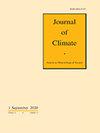Western North Pacific monsoon vorticity distribution as a potential driver of interannual meridional migration of the boreal summer synoptic scale wave train
IF 4
2区 地球科学
Q1 METEOROLOGY & ATMOSPHERIC SCIENCES
引用次数: 0
Abstract
Abstract On inter-annual time scales, there is significant meridional migration of the boreal summer (May–October) synoptic-scale wave train (SSW) relative to the summer monsoon trough line over the western North Pacific (WNP) during 1979–2021. The associated plausible physical reasons for the SSW meridional migration are investigated by comparing analyses between two distinct groups: atypical SSW years where SSWs tend to prevail northward of the summer monsoon trough line and typical SSW years where SSWs largely occur along the summer monsoon trough line. During typical SSW years, SSWs originate primarily from equatorial mixed Rossby-gravity (MRG) waves and then develop into off-equatorial tropical depression (TD) waves in the lower troposphere of the monsoon region. During atypical SSW years, SSWs appear to be sourced from upper-level easterlies, propagating downward to the lower troposphere in the monsoon region, with a prevailing TD wave structure. A budget analysis of barotropic eddy kinetic energy suggests that interannual meridional SSW migration is closely related to changes in the vorticity distribution along the summer monsoon trough over the WNP, especially the western part of the summer monsoon trough. These changes cause low-frequency zonal convergence and shear differences, changing barotropic conversion around the monsoon trough and modulating interannual SSW meridional movement. In response to these changes, there are corresponding differences in SSW sources: a predominate MRG-TD wave pattern in typical SSW years and a predominate TD wave pattern in atypical SSW years. These results improve our understanding of the interannual variability of the large-scale circulation and tropical cyclones.西北太平洋季风涡度分布是北半球夏季同步尺度波列年际经向移动的潜在驱动力
摘要 在年际时间尺度上,1979-2021年期间,北太平洋西部(WNP)的北方夏季(5-10月)同步尺度波列(SSW)相对于夏季季风槽线有明显的经向移动。通过比较两组不同年份的分析结果,研究了 SSW 经向迁移的相关物理原因:非典型 SSW 年(SSW 趋向于夏季季风槽线以北)和典型 SSW 年(SSW 主要沿夏季季风槽线出现)。在典型的 SSW 年,SSW 主要源于赤道混合罗斯比重力(MRG)波,然后在季风区对流层低层发展成赤道外热带低压(TD)波。在非典型 SSW 年,SSW 似乎来自高层东风,向下传播到季风区的对流层下部,并以 TD 波结构为主。对气压涡动能的预算分析表明,经向 SSW 的年际迁移与夏季季风槽沿西太平洋上空涡度分布的变化密切相关,尤其是夏季季风槽的西部。这些变化引起低频地带性辐合和切变差异,改变季风槽周围的气压转换,并调节 SSW 年际经向移动。针对这些变化,SSW 波源也出现了相应的差异:在典型 SSW 年,MRG-TD 波模式占主导地位,而在非典型 SSW 年,TD 波模式占主导地位。这些结果加深了我们对大尺度环流和热带气旋年际变化的理解。
本文章由计算机程序翻译,如有差异,请以英文原文为准。
求助全文
约1分钟内获得全文
求助全文
来源期刊

Journal of Climate
地学-气象与大气科学
CiteScore
9.30
自引率
14.30%
发文量
490
审稿时长
7.5 months
期刊介绍:
The Journal of Climate (JCLI) (ISSN: 0894-8755; eISSN: 1520-0442) publishes research that advances basic understanding of the dynamics and physics of the climate system on large spatial scales, including variability of the atmosphere, oceans, land surface, and cryosphere; past, present, and projected future changes in the climate system; and climate simulation and prediction.
 求助内容:
求助内容: 应助结果提醒方式:
应助结果提醒方式:


